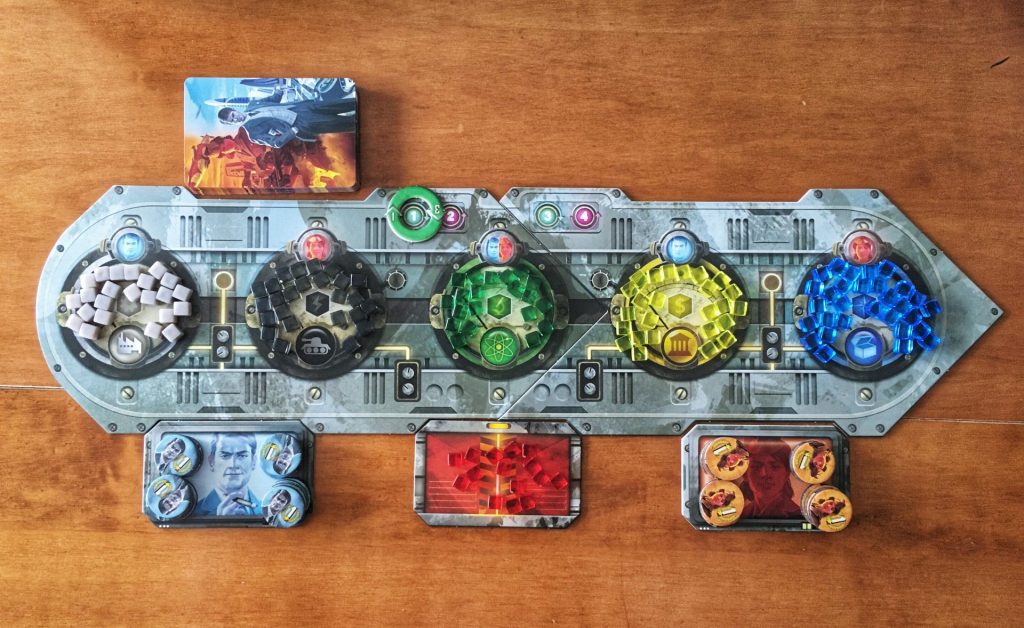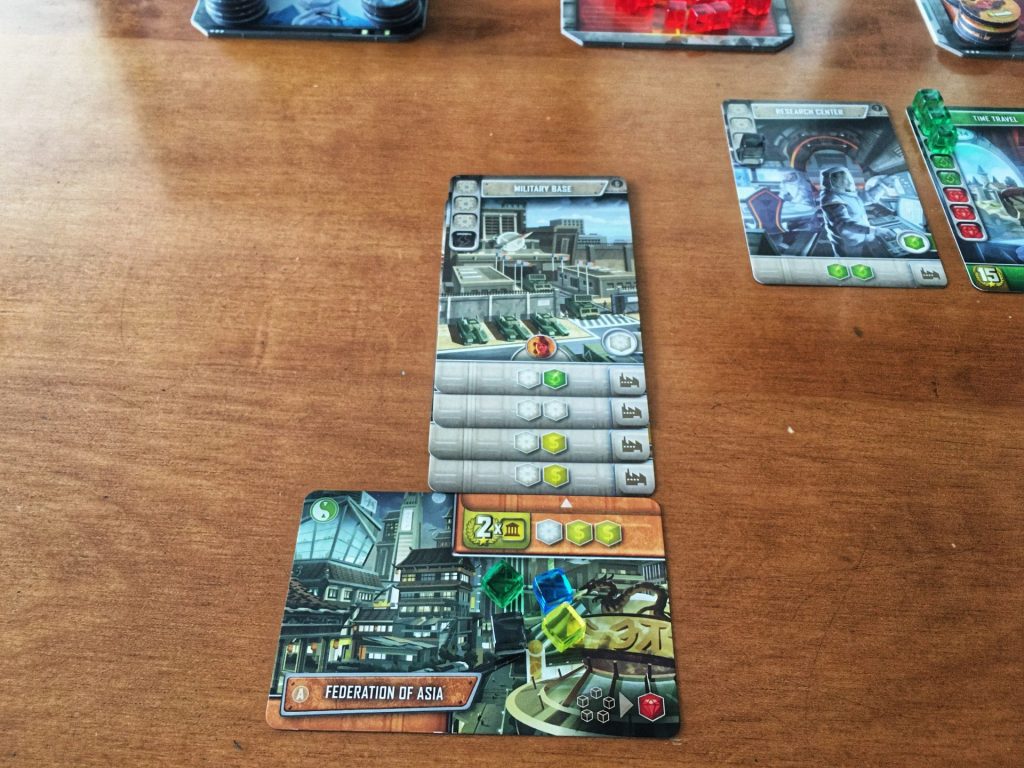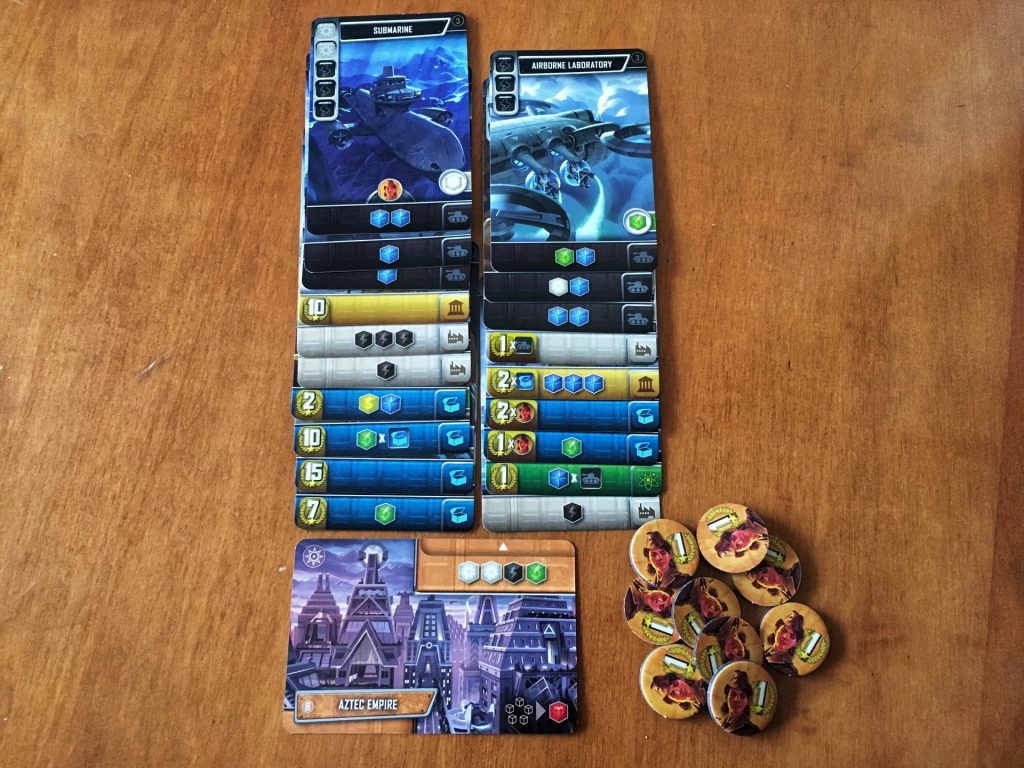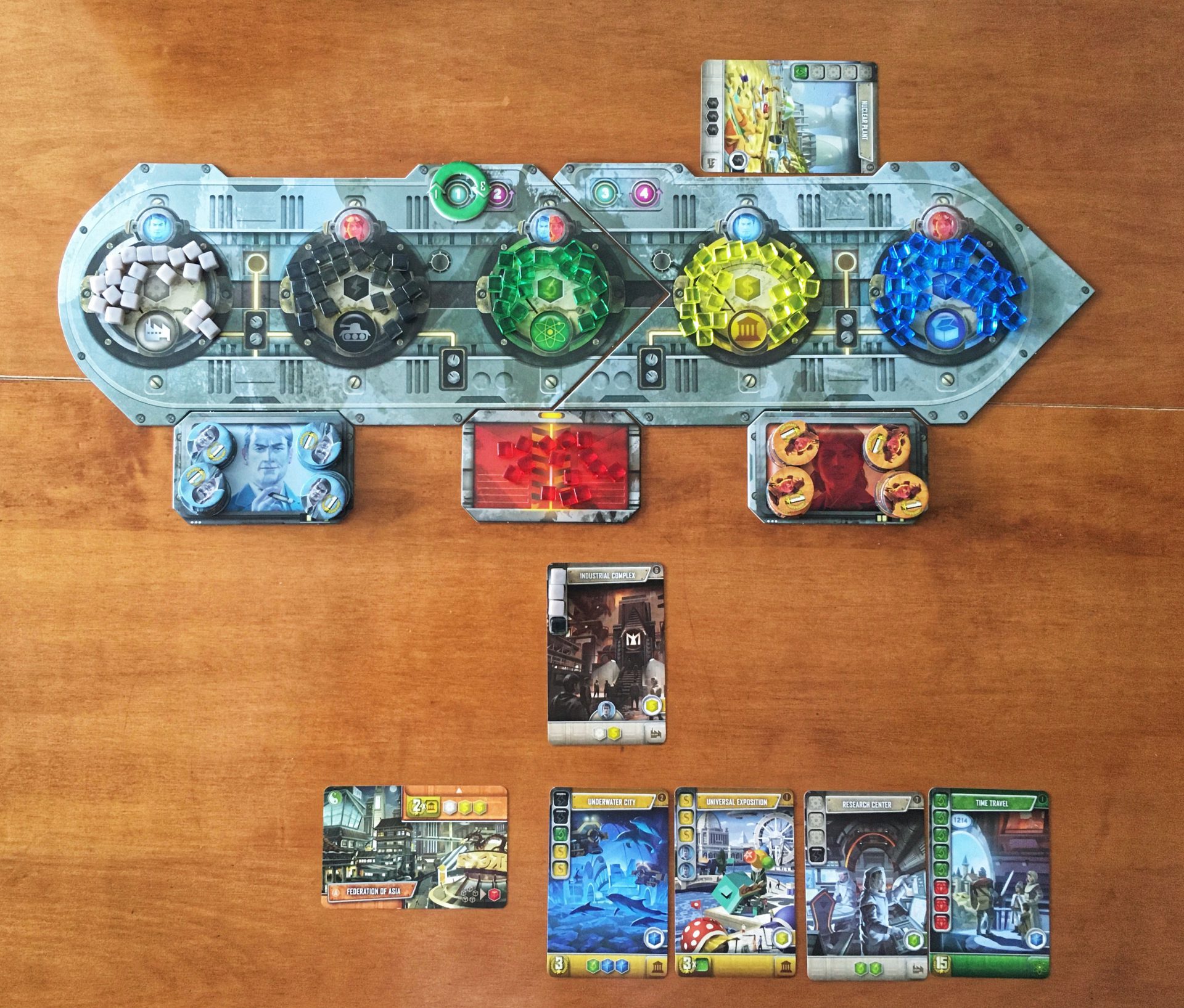It’s a Wonderful World is a card drafting, engine building game for 1 to 5 players in which players are at the helm of an expanding Empire. During the 4 rounds of the game, players draft cards to use as resources and develop their Empire. Cards that players construct could give them resources to spend every round or end-game victory points. The player who builds up their Empire the best, making the most of their cards each round to score the most points, wins the game.

You can also check out our video review of It’s a Wonderful World.
The Way of the World
A game of It’s a Wonderful World lasts 4 rounds, each of which consists of 3 phases: Draft, Planning, and Production. There are no player turns in this game so all actions are performed simultaneously.
Hey there, my name’s Smash! You might see me pop up in Ashley’s pieces from time-to-time to offer helpful insight or advice.
The Weight of the World – Draft Phase
In the Draft Phase, players are each dealt a hand of 7 Development cards. From these cards, they each choose 1 and put it facedown in their Draft Area. Then they pass the rest of the cards to the player on their left (in rounds 1 and 3) or their right (in rounds 2 and 4). Next, players simultaneously reveal their chosen card.
Unlike many drafting games where players immediately perform an action with their drafted card, in It’s a Wonderful World players draft all 7 cards before deciding how to use them.
Players continue drafting a card from their hand, passing the remaining cards on, and revealing the chosen card until everyone has 7 Development cards in their Draft Area.

You want to be careful and aware of what you are passing to your neighbour since It’s a Wonderful World is a drafting and engine building game. The last thing you want is to feed an opponent’s thriving Empire.
Make Way in the World – Planning Phase
Now, with 7 Development cards in their Draft Area, players must choose how they will use each of their cards. They have 2 options for each card:
- Slate it for Construction, by moving the card into their Construction Area, or
- Recycle it, discarding the card for its Recycling Bonus.
Let’s take a look at the anatomy of the Development cards to better understand how these 2 options work.
The Development Cards

Each card has a name, an icon indicating its card type, and the number of copies of it in the game (labelled A, B, and C respectively in the picture above). Cards also have a Construction Cost (D); these are the resources a player must gather for the card if it’s in their Construction Area.
Looking back at the 2 ways a player may use a card in the Planning phase, if they slate a card for construction they are committing to eventually paying the card’s Construction Cost (you’ll learn how this is achieved shortly). If they construct it, they also earn the Construction Bonus (E). Strategically choosing which cards to slate for construction is important because they score you points at the end of the game, but they are also how players shape their engines. The points you score are listed in the bottom left-hand corner (F); you might score straight victory points, points for the number of constructed cards of a certain type, or points for bonus tokens. These points stack so if you have 2 cards that score like F1, you would earn 6 points for every green Development card you constructed at the end of the game.
Players can also build their engines by choosing cards that give them Production (G). For every card that you have completely constructed, you earn the Production (cubes) shown at the bottom of the card during the next phase. These resource cubes are placed on cards in a player’s Construction Area, thus allowing them to construct more Development cards.
When you’re building your engine in It’s a Wonderful World, it can help to think thematically. For example, Vehicles mostly generate Exploration cubes to complete Discovery cards, but they never generate Gold for Projects.
How about the second way players use cards: recycling them? Every card also has a Recycling Bonus (H) so when a player chooses to recycle (discard) it, they gain the pictured resource from the supply. They then must place this resource cube on a card in their Construction Area (i.e. a card currently under construction) or on their starting Empire card. If you place the resource in the final space of a card’s Construction Cost, you immediately complete its construction, returning the resources to the supply, and placing the card in the Constructed Cards Area of your Empire. If there’s a Construction Bonus, you gain this now.
Set the World on Fire – Production Phase
During the Production phase, players receive resource cubes matching the number of icons they have on their constructed Development cards in their Empire and the way in which this occurs is interesting; production occurs sequentially.

Each Production step (the type of resource production) is resolved as follows: first, all players check their production of this resource by counting the number of icons in their Empire (this includes constructed cards and a player’s starting Empire card). Next, players compare their production total for this resource and, if a player produces the single most, they receive the Supremacy Bonus for that resource.

Finally, each player takes a number of resource cubes equal to their production value and immediately places them on cards under construction (in their Construction Area) or on their starting Empire card. Resource cubes can’t be saved for a later phase or round and, once placed, cubes cannot be moved to other cards. If, just like in the Planning phase, you complete a card under construction, this card is added to your Empire immediately.
Since Production is resolved sequentially, it’s possible to finish a Development card’s construction early on in this phase and have it produce resources for you that same round.
What’s with the Empire Card?
A player’s starting Empire card gives them a base Production and might also give them points depending on whether playing with the A or B side.
The A side of the cards are asymmetrical, whereas all players start with the same base Production on the B side. Interestingly, the asymmetrical side of the Empire card is recommended for beginners.
This card also holds resource cubes which a player cannot, or does not want, to play on a card under construction. As soon as 5 resource cubes are on their Empire card, they exchange them for 1 (red) Krystallium cube. Krystallium may be used at any time during the round to act as a “wild” and replace any resource Construction Cost.

Unfortunately resource cubes on a starting Empire card only produce Krystallium and they may no longer be used on cards under construction.
Some Development cards require Krystallium as a resource and some might even require the red General or blue Financier tokens (which are earned through Supremacy and Construction Bonuses).
After the final Production step is resolved (Exploration/blue) the round is complete and the round tracker is flipped and moved forward. Any cards under construction, along with their resources, remain in a player’s Area from round to round.
End of the World Game
The game ends after the fourth round. Players then score victory points for their constructed cards and 1 base point for each General and Financier token.

Changes with Two
It’s a Wonderful World has modified rules for a two-player game. Before you go running in fear of having to play with a dummy city player, this game doesn’t do that. So that you see a good spread of Development cards in a two-player game, each player is dealt 10 cards instead of 7 in the Draft phase. The draft happens in the same way, but when only 3 cards remain in hand, they are discarded (and no Recycling Bonus is gained). As such, players will still have 7 Development cards in their Draft Area, but they see a greater variety of cards.
It’s a Wonderful World works at every player count because the drafting is simply the way by which players build their engine, which is the main gameplay focus.
In a World of One’s Own
It’s a Wonderful World also has 2 solo modes. A solo drafting game? How could this possibly work, you might wonder? Without getting into rules details, trust me, it does! The designer, Frédéric Guérard, has found a way to maintain the soul of what makes a good drafting game and has adapted it to work in a solo game without the use of dummy players or bots, while still having it be a challenging gameplay experience.
As the rulebook mentions, drafting allows players to “select cards while minimizing the luck factor of the draw”. It also gives players direction for their strategy. The solo mode maintains this wonderfully.
The modified solo rules are the same for both modes: the first has you compare your score to a chart while the second, more difficult mode is scenario-based.

A World of Good – Final Thoughts
At first blush, It’s a Wonderful World doesn’t seem like it offers anything new or exciting: it’s a pretty standard drafting game with some engine building. However, the timing of every move you make in the game, especially during the step-by-step Production phase, is what makes this game stand out. Drafting a full set of 7 cards before taking any action also makes It’s a Wonderful World an incredibly thinky experience. Sitting around the gaming table, you’ll hear players mumbling to themselves as they plan out how to best use their drafted cards in the Planning phase, deciding which to put under construction and which to recycle for resources.
If you are familiar with drafting games, you’ll know that there are two key design elements that keep a drafting game interesting: imperfect information when it comes to the cards and a good alternative action for a drafted card you don’t need. It’s a Wonderful World does this by including enough cards in the base game that even with a full player count of five, you never see all the cards. Players are also given a helpful alternative for cards they don’t need: discard them for their Recycling Bonus. This makes denial drafting a little more tempting, yet it also means that players won’t always be able to mess with your strategy—no matter how hard they might try—since you will still have options. You’re also never restricted by your cards under construction because, at any time, you can give up and discard them for their Recycling Bonus. Unfortunately this means any Construction Costs that were already paid are also discarded and wasted. This option, especially in the final round, can really help players complete their high-scoring, game-end cards when production might be less important.

Often drafting games can be hard to teach to new gamers because of the iconography (I’m looking at you, 7 Wonders). In comparison It’s a Wonderful World is easy to teach and has a low barrier of entry because the complexity of the game isn’t in learning it, it’s in how your strategy unfolds as the game progresses. The rulebook definitely helps with learning too; it’s clear, concise, and features excellent visuals and flowcharts to accompany the descriptions of each phase of the game. It also defines the drafting mechanism and the purpose of its use in board games!
The theme of It’s a Wonderful World is still a bit of a question mark for me: is it set in a dystopian society, is it post-apocalyptic, or is it neither? Even with this question mark hanging over my head, I have found that this strange theme often drives my strategy. The cards, which are grouped thematically, add a flavour of theme to the game, which for me make sense. Blue Discovery cards, for example, feature things like Atlantis and the Fountain of Youth and are more rare (only one copy of each card in the game) whereas gray Structure cards are a little more common and help players increase their production. If you consider this during the game when you are drafting, it makes decisions a little easier.
When Lucky Duck Games puts their name on a game, I’m the first in line. Whether it is an analog implementation of a digital game (Fruit Ninja, Vikings Gone Wild, and Jetpack Joyride), an app-based board game (Chronicles of Crime and Time of Legends: Destinies), or any other unique design (Mutants), I’m all over it because I have yet to be disappointed by them. It’s a Wonderful World might initially seem like an average card drafting, engine building game, but the way these two mechanisms work together with the sequential resource production really make this game shine. It’s a Wonderful World? What a wonderful game.
Thematic Music for Playing It’s a Wonderful World
Mémoires vives by Grand Blanc
Songs to check out include: Bosphore, Verticool, Désert désir, L’amour fou, and Samedi la nuit.
More info on Grand Blanc or check out Grand Blanc’s Arte Concert (2016) recorded at Studio Kerwax.
Machine Dreams by Little Dragon
Songs to check out include: Looking Glass, Feather, and Blinking Pigs.
More info on Little Dragon: https://little-dragon.net/
TRON: Legacy Soundtrack by Daft Punk
Songs to check out include: Recognizer, End of Line, and Derezzed.













Great review, highlighting the key features that resonated with our gaming group. We were all pleasantry surprised by the weight of the decision-making in this game (and that was just the retail edition). I’ve already backed the KS reprint and Ascension expansion…
Thank you, Thomas! It was such a wonderful (pardon the pun) surprise for me too. I’m looking forward to the Ascension expansion as well.
Amazing article Ash!
Thanks for this. I just started playing it with my friends and I’m diligently looking for new strategies and principles online now hahah.